We Were Here Expeditions: The FriendShip review
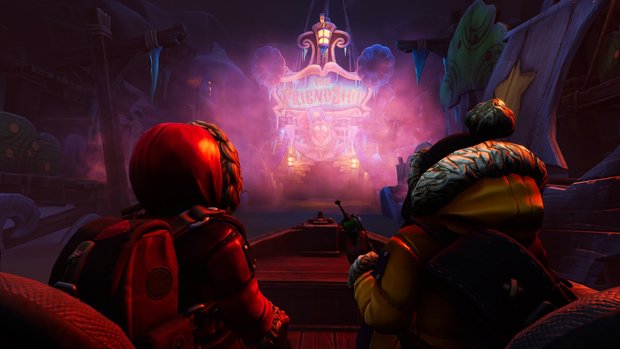
- 0 Comments
Popular co-op puzzle franchise embarks on fun new spinoff series
Total Mayhem Games is back with another installment in their co-op adventure series, this time with some changes to the familiar formula from the previous four games. Dubbed We Were Here Expeditions and carrying the subtitle of The FriendShip, this new entry is intended to be the first in an ongoing series of shorter games – although shorter is a relative term, as it still offers a fun evening’s entertainment for two players. With a bump in the graphics department and a few adjustments to the long-running series’ game mechanics, this is a very rewarding outing in its own right and a promising new beginning indeed.
Those who have followed the We Were Here franchise since it began will be right at home here, though no prior knowledge is needed. The two nameless, face-covered protagonists are dressed like the arctic expedition explorers of the previous entries, though this time the game relocates from a creepy subterranean fortress/castle to a pirate-themed fun park set somewhere in an icy sea. Similarly, the former storyline of the Jester and the King is now gone, replaced by a jolly though judgmental pirate lady who speaks through mechanized wooden cutouts mounted through the park. Her goal is to see if the two visitors can co-operate effectively with one another, with the implication that they are to be paired for some greater task in the future.
After a harrowing opening cutscene of the two explorers tracking a signal through stormy waters, The FriendShip begins with them dropping anchor in their small sailing ship just off the coast of the island with the fun park. They row in on a raft and a brief puzzle section ensues in which the two have to find a way inside. This serves as a tutorial for the controls, which are standard for free-roaming, first-person 3D games. After that, you are put through three trials testing communication, teamwork, and trust.

Each of these sections offers up a different type of challenge. As a new wrinkle, the puzzles do not need to be completed in full in order to proceed through the game. For example, the first sequence sees you and your partner separated into different rooms. With a timer counting down, one person has to describe the pose of a little wooden puppet, which triggers a bit of descriptive back and forth between both players, resulting in pressing an appropriate button.
This same basic sequence, with different puppet poses, can be repeated up to fifteen times, with the amount of time available decreasing with each iteration. For the first five of these, one player sees and describes the puppet and the second helps them determine what button to push. For the next five, the roles reverse and then, for the final five, players alternate back and forth with each step. This sounds repetitive, but each round only takes a few seconds, meaning the entire sequence can be done in a couple of minutes.
Even then, players who struggle with timed puzzles are looked after here, as only the very first one has to be finished. After that, failing any of the subsequent iterations – whether intentionally or from making a mistake or taking too long – will bring that puzzle section to a close. Based on how many of the fifteen are completed, your team is awarded a bronze, silver, or gold ticket out of a dispensing machine. At that point, the pirate captain summons you back to your small tunnel-of-love-type of boat that serves as transportation through the amusement park. Except you don’t have to leave right away. If you want, you can shred your ticket and try the entire puzzle section over to improve your standing. It’s a great way of allowing players to move past puzzles they’re unable or uninterested in completing in their entirety, while letting those having fun with them to play as much as they’d like.
Whenever you’re ready to move on, your ticket is fed into a machine that upgrades your little park boat with increasing levels of bling – purely for cosmetic purposes. At the end of the game, the final results for how well you did are tabulated for each challenge and presented in a sort of summary screen.
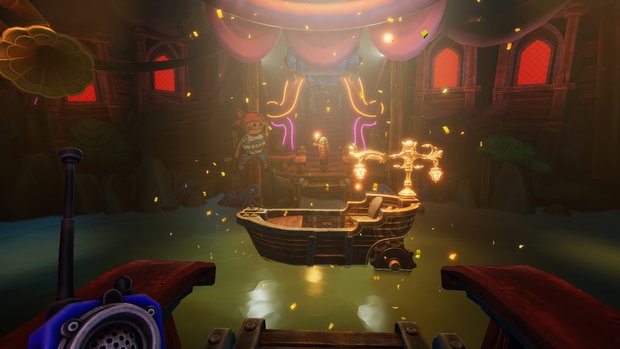
In addition to the timed puppet puzzle, The FriendShip has two more major sequences. The first sees you separated by a wall, but with a scoreboard at the end of the chamber in which the puzzle takes place. On either side of the wall is a game board of sorts, comprised of large hexagonal slots engraved into the ground. On the dividing wall, each player can choose one of three tiles to place into their board. One player has tiles that are entirely red, green, or blue; the other player has patterned tiles of the same colours. Players alternate between placing these tiles on their own game boards, which scores points on the scoreboard at the end of the room. There’s a connection between the two boards, and figuring it out is part of the challenge.
Once both players have placed their first tiles, a new set appears. You then have a fixed number of turns to place tiles and form the largest groups of all three colours that you can. But it’s not as simple as both players making the colour areas on their own game boards as big as possible. When one player places a tile, it limits the options of where the other player can place their tile. Again communication is the key, and players have to work together to ensure the choices they make don’t limit what their counterpart can do. Points are calculated based on the largest size of each of the three colour groups from both players. The higher the points at the end of the turns, the better the prize ticket will be – again bronze, silver, or gold. And here too you have the option to replay the entire minigame to attempt a higher score.
This tile-laying sequence was a surprisingly dramatic change from the earlier puppet challenge. The first relies on the two players being able to quickly and accurately describe patterns, while the second is a more focused mental exercise. They’re followed by a third that is every bit as different from the preceding two. This one is a real trust exercise; here one player oversees an obstacle course that the other must navigate. The one going through the course gets gassed with a hallucinogen at the beginning so is unable to trust what they see. That player must depend on the directions provided by the overseer to get through a series of increasingly challenging obstacles.
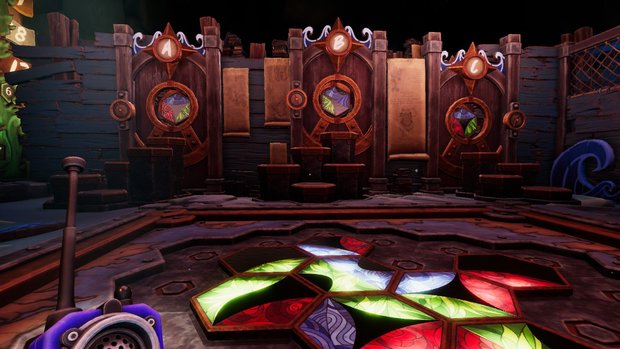
This was my personal favourite, as it requires a lot of clear communication to circumvent the various hazards. At first navigation is fairly straightforward, involving the overseer directing the runner to follow a series of dockside paths made of wooden planks. The runner can vaguely see the paths, but they’re blurry on that screen, making it difficult to judge where the edges are. Stepping off the edge drops the runner into the water below, which ends that attempt. Throughout this stretch, the runner must press buttons on small lighthouses, which is what you’re judged on for getting your bronze, silver, or gold tickets. An early opt-out option is once again available, as you could potentially proceed with as little as a single successful button press.
As you get farther into this segment, the obstacle course becomes more challenging. The runner moves on from simple fixed paths to platforms that drop away or move. The effects of the hallucinogen grow more pronounced, making it increasingly difficult for the runner to make out what’s going on. They must put their faith in the overseer, who’s directing them how to move and when to jump on the moving platforms. In fact, at this point the runner can’t even tell which paths are real, as illusionary bridges become visible on their screen. Stepping on these will of course drop the player into the water.
Two additional segments add new elements, obstacles, and visual impediments (and therefore a higher degree of difficulty), to the point that the runner can eventually see nothing and is entirely dependent on the overseer guiding them through. It’s an intense, but fair, sequence to complete in its entirety and feels like a major accomplishment in teamwork to get all the way through.
When I played this last section with my friend, I was in the overseer role. I’m not exactly sure how things looked to my friend – he described them as best he could – but for me they looked quite impressive. From my position I could view the entirety of this area, an expansive region with a lot of great detail. Which didn’t come as a surprise to me, as the graphics have steadily improved over the course of the We Were Here series, and The FriendShip represents the next step up.
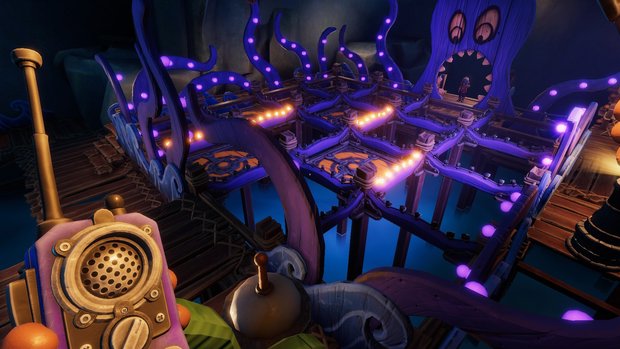
Models, especially for the two player characters, have a noticeably higher polygon count here, and the level of texturing has crept up, with some nice touches like the stitching on the characters’ gloves. The various mechanical devices that can be interacted with have a lot of style, looking like retro sci-fi fairground kiosks. At the center of the park, connecting the puzzle areas, is a canal. Rafting down it feels like riding It’s a Small World at Disneyland, but without the singing. The one downside to the game visually is that the graphics settings default to their lowest options. While it still looks good like this, it’s not nearly as sumptuous as when the detail levels are cranked up.
Another minor complaint is that The FriendShip carries over the wonky field of view used by default in the previous title, which causes the graphics to stretch significantly at the edges of the screen. This was especially noticeable on my friend’s ultra-wide monitor, where the small two-person boat the protagonists initially sail in on was so stretched it looked like a mammoth cruise liner. Fortunately, the field of view can be tightened in the game settings so that moving around the environment isn’t nausea-inducing.
The new setting and storyline are certainly welcome. It’s nice to get away from the Jester and the King, a tale that had run its course in the previous adventures. The new speaking role, that of the captain lady, is nicely voiced, sounding joyful, smug, and somewhat ominous at the same time. While nothing “bad” happens here, I definitely came away with a muted sense of foreboding and an interest in seeing what happens next.
The rest of the audio fits the environment well: steampunk-esque contraptions whistle and creak as one would expect, and water splashes when sailing from one puzzle to the next. The instrumental music is suitably melodic and fits comfortably into the background. It’s a pleasing accompaniment that never calls attention to itself or is too overpowering, which is good for a game like this as it doesn’t interfere with players talking back and forth to one another.
As with previous games in the series, players can communicate over a pair of in-game radios. Holding down a button allows one player to talk to the other via their real-world microphone, and vice versa. Only one person can talk at a time this way, and we didn’t see any value in regimentally alternating communications, so my friend and I eschewed it and used a third-party chat application that allowed us to freely speak back and forth – even just shooting the breeze – without any need for the walkie-talkies. It’s been a while since we played the last game, but we quickly fell into the rhythm of conveying what we were seeing on our respective screens. In doing so we had a lot of fun and shared a lot of laughs over the course of our two-hour play time in pursuit of all three gold tickets.
Final Verdict
We Were Here Expeditions looks set to be a great new series of its own in the We Were Here franchise. This shorter debut game was perfect for an evening’s play that felt very satisfying and yet left both my friend and I wanting more. The option to only partially complete puzzle sequences when you’ve had enough is an excellent addition, especially in light of some of the frustratingly tight timed puzzles of previous games. The variation between the game’s three major puzzle sections keeps things fresh and enjoyable without ever feeling repetitive. And while story has never been a big component of these games, this one begins a brand new tale, making it the ideal entry point for newcomers to the series as well as longtime fans. Either way, if you’ve got a friend to play with, round them up and have some fun with this excellent co-op jaunt through a piratey theme park.
Hot take
With a new storyline and new tweaks to the series’ co-op gameplay, We Were Here Expeditions: The FriendShip is an excellent start to this multi-part franchise installment.
Pros
- Nice variety in the three major puzzle types, with welcome opt-out mechanics when you’re ready
- Great audio-visual presentation that really evokes a sense of wonder in a pirate-themed fun park
- Voice of the pirate captain is excellent
- Perfect length for an evening’s play
- New storyline that whets the appetite for future installments
Cons
- Default graphic settings don’t do the improved visuals justice
Richard played We Were Here Expeditions: The FriendShip on PC while available free for a limited time.


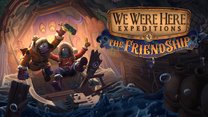







0 Comments
Want to join the discussion? Leave a comment as guest, sign in or register in our forums.
Leave a comment